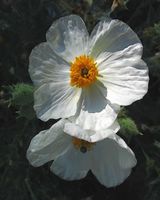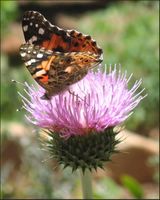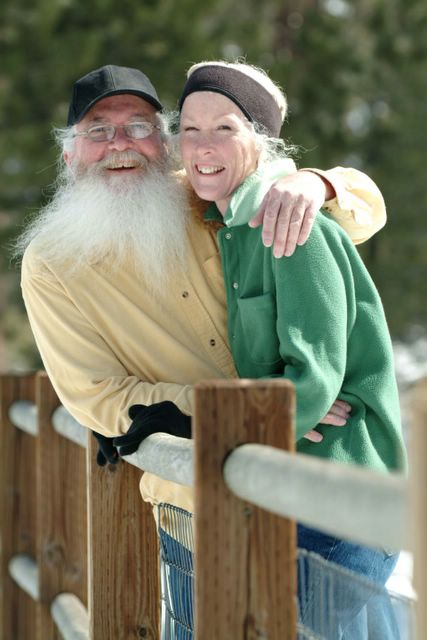
 How did we get here?We were asked this question at a sustainable living forum about our car-free lifestyle.
How did we get here?We were asked this question at a sustainable living forum about our car-free lifestyle.
It was a big question requiring a long answer.
Here is my response, I think it will give you an idea of who were are. The place we are at in our lives right now is just another small step among many steps that are leading us along our path.
The main reason we have arrived at this particular point has more to do with what we couldn't, or wouldn't do, than what we planned on doing.
I just couldn't work in certain industries because of their contributions to war efforts, or the toxic polluting side-effects of their products.
I also couldn't stand working indoors, and took a job as a mailman, just to save a few bucks so I could travel.
Once I started walking around all day, delivering mail to people, I fell in love with the job.
This was before the advent of mass mail marketing, and all the junk mail that was then generated to fill our landfills with what used to be our forests.
And by the time I became active in trying to encourage the Post Office to recycle (a mostly futile effort) I was well into my career.
Peggy and I both have a strong aversion to congestion, traffic, noise, pollution, concrete and asphalt, and as soon as I finished high school in the San Fernando Valley (outside of Los Angeles), when my friends all rented apartments with pools in Reseda for $125 a month, I ran for the shelter of the Santa Monica Mountains, renting a little shack in Topanga Canyon for $65 a month.
They all thought I was crazy.
When inflation took off in the 70's my sacred mountains became increasingly unaffordable on a postmans salary, so when Peggy and I got married in 1979, we couldn't find a place we could afford that we were willing to live in.
A tiny duplex or condo in the foothills (no kids-no pets allowed-and rules & regulations up the kazoo) was going for $125,000 and interest rates were very high (around 11 or 12%). We didn't want to live in a place we hated and be saddled with a huge mortgage, so we started looking for somewhere to move to.
Our postal jobs allowed us the freedom to transfer to another location, and my uncle lived here in Big Bear, where he sold real estate.
We bought this little 950 sq ft cabin in December of 1980 for $72,000, all knotty pine, huge fenced in yard and pine forest everywhere.
We immediately put in for transfers so we could get out of the L.A. area and into our lovely little vacation cabin.
Again, our friends thought we were crazy.
It took some time, but we finally got transfers and moved up here a little over 2 years later, on April 1st of 1983.
Peggy was transferred to the Big Bear City Post Office, 1 1/2 miles from our house, and began walking to work whenever she could.
I was stationed in Apple Valley, 40 miles from here, and had to commute there for 8 years (they were very difficult years and I began to think our friends were right) before getting transferred to Big Bear Lake, 4 miles from home.
We had always considered ourselves environmentalists, driving compact cars, recycling, being active in conservation groups and supporting causes like public transportation, habitat preservation, restoration, and social responsibilty, that sort of thing.
But living without TV has perhaps had the greatest impact on the direction our lives have taken. In my adult life I've only owned a television for two short periods, once in my 20s, when I was laid up for several months with a badly broken leg, a friend gave me one to keep me company.
And when our kids were in elementary school we had family meetings where anybody's grievances might be addressed. Well the kids said we were being very unfair not letting them have a TV, they felt so out of it at school (I so wish we had home-schooled) when all the other kids talked about their favorite shows & "stars", and my kids were clueless.
So we relented and agreed they could have TV under certain conditions, or the TV would go.
No sooner was the thing in the house when the agreement was violated time and again, so out went the tube after a couple of months.
It's not that there's absolutely nothing on TV to like, there may be, but there's just too much to dislike!
The time most families spend in front of the tube, we spent playing board games, doing crafts, or just going outdoors to play.
We see TV as a media tool for brainwashing, for maintaining the status-quo, & basically just can't stomach it!
So again, it's not so much what we could do that has guided us as what we couldn't do.
Then along came the first Gulf War! There were our tax dollars flying through the air in million dollar scud missles killing innocent men, women & children, destroying lives & families, so we could have abundant access to the cheap oil fueling our wasteful lifestyles.
We started driving less, the car stayed in the driveway much of the time, and we bought bicycles for the whole family.
One day in 1996 Peggy used the car to drive our daughter to a birthday party across town.
On the way home she was hit in the drivers door by a kid going 60 miles an hour through a blind intersection.
It's a miracle she's alive, and even more of a miracle that she wasn't seriously injured.
The car was nearly a total loss, but they repaired it, and then it sat in the driveway for another year.
We had already been walking or riding our bikes to work for several years when we began to realize that decisions we'd made over the years, through avoidance of things we didn't care for, had brought us to this small community where everything we needed was within walking or bicycling distance, including our jobs.
Rather suddenly, we became more acutely tuned to our own instincts, and started making deliberate changes in our lives.
Around that time, out of curiosity, I wrote a letter to the National Transportation Safety Board asking for statistics on traffic deaths and, to my surprise, they sent me a complete list of yearly fatalities since about 1906.
By the mid 1990s over 3 million Americans had died as a result of automobile accidents.
And that doesn't take into account the scarred lives & bodies, the crippled victims, or the incredible toll on wildlife that has been killed by cars and displaced by habitat destruction, or an entire century of air & water pollution and strip mining.
We didn't need the car anymore, and we came to see it as a liability not an asset.
Our lives, and life on earth itself, were suddenly much more important than a car.
We just couldn't do it anymore and we didn't have to.
My wife first suggested that we try living without it for awhile so we made a pact to go one full year and then re-assess our feelings about it.
A year later, to the day, I asked her with a knowing smile if she wanted to get another car, "when hell freezes over" she smiled back.
For us it has meant newfound freedom.
Freedom from the expense of gasoline, maintenance, tires, oil and insurance.
Freedom from fear, freeways & parking lots, and freedom from being confined in a hurtling tin & plastic capsule.
Our culture, our jobs and our wages, are designed around the automobile, and when you choose not to own one it's like suddenly finding an extra income, life gets easier.
We find that the more we disconnect ourselves from the garbage that is fed to us by the government---and the corporations who run it---the more we feel like the human beings we'd like to be.
We don't see ourselves as yet living up to our ideals, but we are on a path and we're trying. Every change we make brings new challenges that usually guide us in whole new directions.
But it mostly seems like we're just going on intuition, we avoid what we don't like and try to focus on what we love.
I really wish we could have found a way to live without paying taxes for war, murder and corporate welfare, but this is the world we were born into and we all have to find ways to survive.
It's taken a lifetime time to get this far and we are learning every day.
Eventually, we'd like to live each moment with deliberate clarity, and share what wisdom we may have gained as elders. Labels: autobiographical, automobiles, Jim, Peggy, rants, social commentary

 Peggy pumping water from the rainbarrel this morning for the chickens.
Peggy pumping water from the rainbarrel this morning for the chickens.















